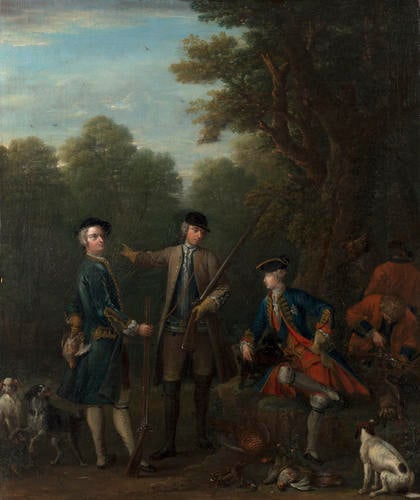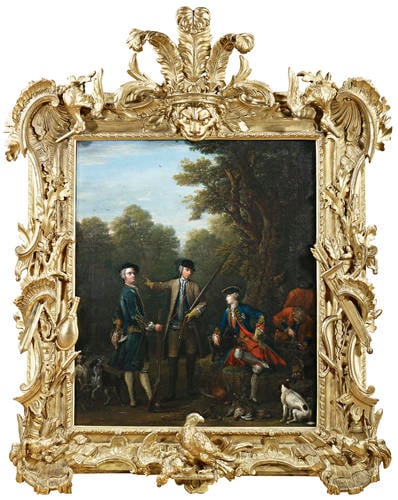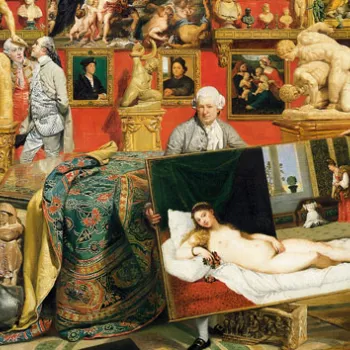The Shooting Party: Frederick, Prince of Wales with John Spencer and Charles Douglas, 3rd Duke of Queensberry Signed and dated 1740
Oil on canvas | 88.9 x 74.0 cm (support, canvas/panel/stretcher external) | RCIN 402421
-
John Wootton, one of the earliest native English painters, was extensively patronised by the Royal family during the reign of George II: Queen Caroline visited his studio in 1732, by which time he was already working for her son, Frederick, Prince of Wales.
Frederick’s earliest commission to John Wootton was for a hunting scene (Frederick, Prince of Wales, Hunting at Windsor, by Wootton and Hogarth, Royal Collection), dated 1734, with the varied and informal interaction of a classic conversation piece and with heads executed by the leading master of the genre, William Hogarth. It differs from other conversations of this date in the prominence given to horses and landscape and the huge scale of the canvas (approximately 7 by 9 foot), designed to decorate the Great Hall of the White House at Kew. Other commissions given to Wootton — for pairs of hunting and battle scenes — were similarly conceived to fill the large spaces of halls and staircases at the Prince’s houses in Kew and Leicester Square. The scale of the figures here is comparable, but the composition reads as a vignette or fragment, with a very different character: instead of the heroic spectacle of a hunt, we have the intimacy of a few friends relaxing during a rough shooting expedition.
John Spencer (1708-46), to the left trying to keep a bird from an eager spaniel, was the favourite grandson of Sarah, Duchess of Marlborough (1660-1744), and succeeded her as Ranger of Windsor Great Park a few years later in 1744. Charles Douglas, 3rd Duke of Queensberry (1698-1778), in the centre pointing in the direction of the party’s next foray, was Gentleman of the Bedchamber to the Prince of Wales. Both men wear a jockey cap, an article of plebeian dress fashionable at the time, and wait upon Frederick, Prince of Wales, who sits nonchalantly on a bank, stroking a dog and wearing his own hunting uniform. Two of Frederick’s liveried servants act as loaders behind and the booty shot so far lies at his feet: hare, pheasant, snipe and kingfisher. The nearest visual precedent for this sporting elegance can be found in French scenes of hunters of both sexes resting or eating en plein air, such as Francois Lemoyne’s Déjeuner de Chasse, 1723 (Alte Pinakothek, Munich). In this comparison the landscape in Wootton’s image acquires a very different character from Lemoyne’s: darkening as evening approaches, heavily wooded and suggestive of the wilder recesses of Windsor Great Park. According to Horace Walpole, Wootton turned to landscape late in his career, following the style of Gaspar Dughet (1615-75, then always called Gaspar Poussin), and sometimes, as in the sky here, imitating ‘happily the glow of Claud Lorrain’ (Anecdotes of Painting in England, 1762).
The magnificent frame was acquired from Paul Petit in 1742 for 20 guineas (probably only slightly less than the painting itself); within the asymmetric rococo carving appear game, dogs, bulrushes and various weapons, all surmounted by a lion’s head crowned with the Prince of Wales feathers.
Signed and dated: JW / 1740Provenance
Probably painted for Frederick, Prince of Wales (only the payment for the frame documented); recorded in store at Carlton House in 1816 (no 283) and 1819 (no 283); sent to the Grand Corridor at Windsor Castle in 1828
-
Medium and techniques
Oil on canvas
Measurements
88.9 x 74.0 cm (support, canvas/panel/stretcher external)
142.5 x 119.6 x 28.0 cm (frame, external)
Category
Object type(s)
Other number(s)
Alternative title(s)
The shooting party: Frederick, Prince of Wales (1707-1751) with John Spencer (1708-1746) and Charles Douglas, Third Duke of Queensberry (1698-1778)










